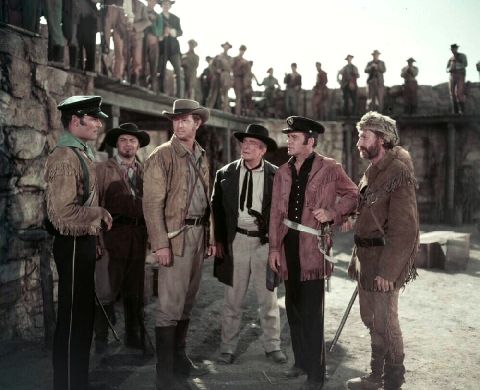The Last Command (1955) 
“SEE! The greatest heroes Texas ever knew, as they live again the fearless stand that ripped a brave, new nation out of the Western Frontier!”

Director: Frank Lloyd
Cast: Sterling Hayden, Anna Maria Alberghetti, Richard Carlson
Synopsis: Moderate Jim Bowie leads rebellious Texicans–and Davy Crockett–in a last-ditch stand against his old friend, Santa Anna.
Back in the 1950s, John Wayne kept banging on at Herbert J. Yates, the head of Republic Studios, to make a movie re-enactment of the Alamo. The studio came up with this modestly budgeted effort and offered Wayne a nominal sum to star in it. Dismayed by Yates’ half-hearted approach, Wayne declined, but Yates went ahead with The Last Command anyway, choosing Sterling Hayden for the pivotal role of Jim Bowie. Five years later, Wayne would make his own big-budget version of the battle, and it would prove to be every bit as lacklustre as this one.
The Last Command spends more time on the politics leading up to the famous stand than the actual skirmish itself. Bowie initially finds himself caught in the middle of a wrangle between a group of rebellious Texans unhappy about their treatment at the hands of Mexican President Antonio Lopez de Santa Anna (J. Carrol Naish) and the President himself, who happens to be a friend of Bowie’s. The Texans, led by the lawyer William B. Travis (Richard Carlson) initially mistrust Bowie because of this, and one of them, Mike Radin (Ernest Borgnine) even unwisely challenges the inventor of the Bowie knife to a knife fight. He clearly didn’t think that one through, and spends the rest of the movie making puppy eyes at Bowie while his wounded right arm hangs lifelessly by his side. It’s strange how often a movie hero wins the undying loyalty of a man by beating the crap out of him when, in real life, the recipient of the beating would either keep as much distance between them as possible or come after him with five mates and a baseball bat.
Anyway, I digress. After losing his wife and daughter to illness, Bowie goes off the rails for a bit before pulling himself together and slowly coming around to the Texan way of thinking. It takes him a while to win over those who feared he was a compadre of the President, but of course he comes through to quell their doubts and win — well, lose, but you know what I mean — the day. All this political to-and-froing takes up a good three-quarters of the movie’s running time, which leaves only a half-hour or so to focus on the actual siege and battle. While this approach provides a more comprehensive background than Wayne’s later version — although, as always with Hollywood movies, the historical accuracy is debatable — it also proves to be pretty dull stuff thanks to a pedestrian script from journeyman writer Warren Duff and Frank Lloyd’s flat direction.
Republic also felt it necessary to tack on a romantic sub-plot for Bowie following the death of his wife. His love interest is provided by 19-year-old Anna Maria Alberghetti, who lacks any kind of personality and plays too often to the camera. Her role proves to be more of a distraction for the audience than it is for Bowie, and it’s a shame that Hollywood hardly ever felt confident enough in its audiences to dispense with a leading lady when the story didn’t really call for one. Things do liven up once Santa Anna’s assault on the Alamo gets under way, and Lloyd handles the action scenes well, but it’s over too quickly and fails to stir any emotion in the viewer simply because the script never really breathed life into the doomed characters in the first place. Also, Republic’s status as a Poverty Row studio means that financial constraints prevent The Last Command from having the epic sweep its subject matter demands. Still — on the plus side, at least Vera Ralston’s not in it…
(Reviewed 24th June 2013)
httpv://www.youtube.com/watch?v=zW1-epuCOs0
